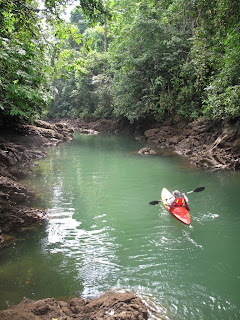After leaving our Tico Familia in San Joaquin, we spent a couple of days in nearby Alajuela. This coincided with election day in Costa Rica, and the Super Bowl in the USA. Election day was a rather festive affair, with people driving around flying their polical colors and madly honking their horns. The favorite, Laura Chinchilla, was elected as the first woman Presidente of Costa Rica. We did manage to catch most of the Super Bowl as well, and were pleased to see New Orleans emerge victorious.
Then it was on to the area around the Arenal Volcano, one of Costa Rica's most popular tourist destinations. We spent the first few days south of Arenal proper, near the "town" of Chachagua, at a remote lodge nestled among the rainforest. The place was pretty much deserted and we enjoyed the surroundings and the many birds, lizards, and frogs to be found there. Walking through the rainforest was particularly nice.
We took a tour to the Arenal volcano, which is one of the most active in the world, having been continuously active since a massive and surprising eruption in 1968 that killed about 90 people. THe volcano was quite sleepy during our visit, and in fact hiding behind the clouds, but our guide was very good and gave us plenty of information about the volcano and local environment. It was amazing to walk through what appeared to be a mature forest, but had in fact been growing on bare lava for only about 15 years.
We splurged a bit and spent a day at a flashy hot springs resort at the bottom of the volcano, which was quite nice, complete with hot and cold water slides, and hot pool with the requisite wet bar. They also had a nice collection of crocodiles, butterflies, and leaf-cutter ants, and we saw lizards and monkeys around the grounds, as well as many kinds of birds.
Refreshed from the hot springs, we spent our last night in La Fortuna, the tourist-trap laden town that caters to the Arenal area, where a good bit of the afternoon and evening was rainy.
Later today it is the Jeep-Boat-Jeep transport to our next stop, Monteverde. Zane will have another week of Spanish school, and the rest of us will do our best to study and keep up with him.
















































